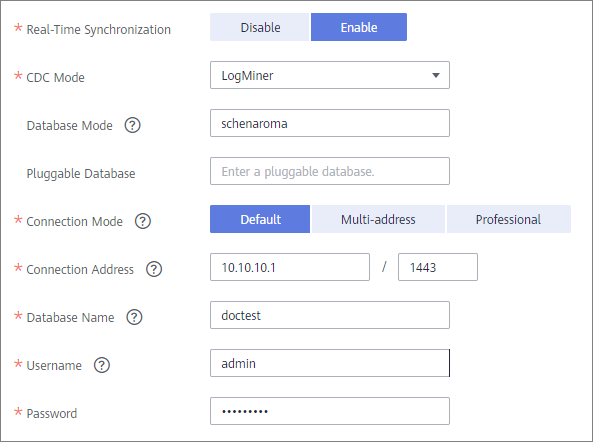Connecting to an Oracle Data Source
Overview
ROMA Connect can use the Oracle database as a data source for data integration tasks or data API creation. Before using the Oracle data source, you need to connect it to ROMA Connect.
Prerequisites
Each connected data source must belong to an integration application. Before connecting a data source, ensure that an integration application is available. Otherwise, create an integration application first.
Procedure
- Log in to the ROMA Connect console. On the Instances page, click View Console next to a specific instance.
- In the navigation pane on the left, choose Data Sources. In the upper right corner of the page, click Access Data Source.
- On the Default tab page, select Oracle and click Next.
- Configure the data source connection information.
Table 1 Data source connection information Parameter
Description
Name
Enter a data source name. It is recommended that you enter a name based on naming rules to facilitate search.
Integration Application
Select the integration application to which the data source belongs.
Description
Enter the descriptive information.
Real-Time Synchronization
Determine whether to enable real-time synchronization for the database. Set this parameter to Enable if Oracle is used as the source data source of a composite integration task.
CDC Mode
This parameter is mandatory only if Real-Time Synchronization is set to Enable.
Select the CDC mode for the database.
- XStream: The CDC function of the Oracle database in XStream mode is used.
- LogMiner: The CDC function of the Oracle database in LogMiner mode is used.
Outbound Server
This parameter is mandatory only if CDC Mode is set to XStream.
Enter the name of the outbound server, which must be the same as that set in Configuring Oracle CDC (XStream).
Database Mode
This parameter is mandatory only if CDC Mode is set to LogMiner.
Enter the name of the schemas where the data table to be synchronized is located. If this parameter is not specified the database username is used by default.
Pluggable Database
This parameter is mandatory only if Real-Time Synchronization is set to Enable.
Enter the name of the PDB where the data table to be synchronized is located.
Connection Mode
Select a database connection mode.
- Default: The system automatically concatenates data source connection character strings based on your configured data.
- Multi-address: You can enter the IP addresses and port numbers of multiple databases. The system automatically concatenates data source connection character strings based on your configured data.
- Professional: You need to enter the data source connection string manually.
Connection Address
This parameter is mandatory only if Connection Mode is set to Default.
Enter the IP address and port number for connecting the database.
Database Name
This parameter is mandatory only if Connection Mode is set to Default.
Enter the name of the database to be connected.
Database Address List
This parameter is mandatory only if Connection Mode is set to Multi-address.
Enter the connection address and port number of the distributed database system. Click Add Address to add multiple addresses and port numbers.
Service Name
This parameter is mandatory only if Connection Mode is set to Multi-address.
Enter the service name of the distributed database system.
Connection String
This parameter is mandatory only if Connection Mode is set to Professional.
Enter a JDBC connection string of the Oracle database, for example, jdbc:oracle:thin:@(DESCRIPTION=(ADDRESS=(PROTOCOL=TCP)(HOST={hostname})(PORT={port}))(CONNECT_DATA=(SERVER=DEDICATED)(SERVICE_NAME={servicename}))).
- {hostname} indicates the IP address for connecting to the database.
- {port} indicates the port of the database.
- {servicename} indicates the service name of the Oracle database to be connected.
Username
Enter the username used to connect to the database.
Password
Enter the password used to connect to the database.
For a common data integration task, the connection configuration of the Oracle data source is similar to that of the MySQL data source. For details, see Connecting to a MySQL Data Source.
For a composite task, the following is an example of connecting to an Oracle data source which is not a CDB database and the CDC mode is LogMiner.
Figure 1 Oracle data source configuration example
- Click Check Connectivity to check the connectivity between ROMA Connect and the data source.
- If the test result is Data source connected successfully, go to the next step.
- If the test result is Failed to connect to the data source, check the data source status and connection parameters, and click Recheck until the connection is successful.
- Click Create.
Feedback
Was this page helpful?
Provide feedbackThank you very much for your feedback. We will continue working to improve the documentation.See the reply and handling status in My Cloud VOC.
For any further questions, feel free to contact us through the chatbot.
Chatbot





